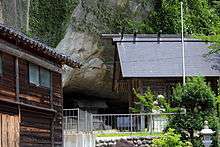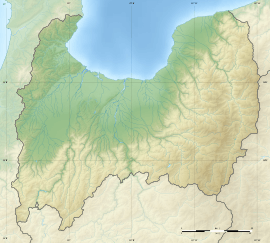Ōzakai Cave Dwelling Site
Ōzakai Cave Dwelling (大境洞窟住居跡, Ōzakai dōkutsu jūkyo ato) is an archaeological site consisting of a cave dwelling in what is now part of the city of Himi, Toyama Prefecture in the Hokuriku region of Japan. The site was designated a National Historic Site of Japan in 1986.[1]
大境洞窟住居跡 | |
 Ōzakai Cave Dwelling Site | |
 Ōzakai Cave Dwelling  Ōzakai Cave Dwelling Site (Japan) | |
| Location | Himi, Toyama, Japan |
|---|---|
| Region | Hokuriku region |
| Coordinates | 36°55′22.0″N 137°1′48.8″E |
| Type | settlement |
| History | |
| Periods | middle Jōmon though Kamakura |
| Site notes | |
| Ownership | National Historic Site |
| Public access | Yes |
Overview
The site was discovered when a Shinto shrine was being renovated near the fishing port of Himi in 1918. With a large natural cave, a number of bones and pottery fragments were discovered and during a subsequent excavation by the Tokyo Imperial University, earthenware, ceramics, the bones of approximately 20 people and animal bones were found.
The cave has a depth of 35 meters, with an entrance 16 meters wide, and 8 meters high. The current floor is about 4 meters higher than the present sea level. The site was the first cave site in Japan and stratigraphic examination indicated that it had been occupied from the middle Jōmon period through the Kamakura period:
- Layer 1: Kamakura period to modern: ceramics · iron swords etc.
- Layer 2: Nara and Heian period: Sue ware, Haji pottery
- Layer 3: mid- to late-Kofun period: earthenware, animal remains
- Layer 4: mid-Yayoi period to early Kofun period: human bones, animal remains
- Layer 5: late Jōmon period to early Yayoi period: Earthenware, stoneware, bone horn vessels, human bones, animal bones
- Layer 7: mid-Jomon period: Earthenware, stone tools, animal bones
References
- "大境洞窟住居跡" [Ōzakai dōkutsu jūkyo ato] (in Japanese). Agency for Cultural Affairs.
External links
- Toyama tourist information home page (in Japanese)